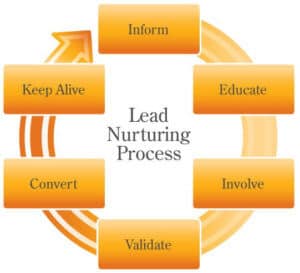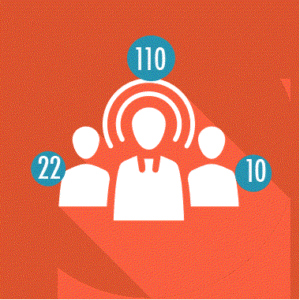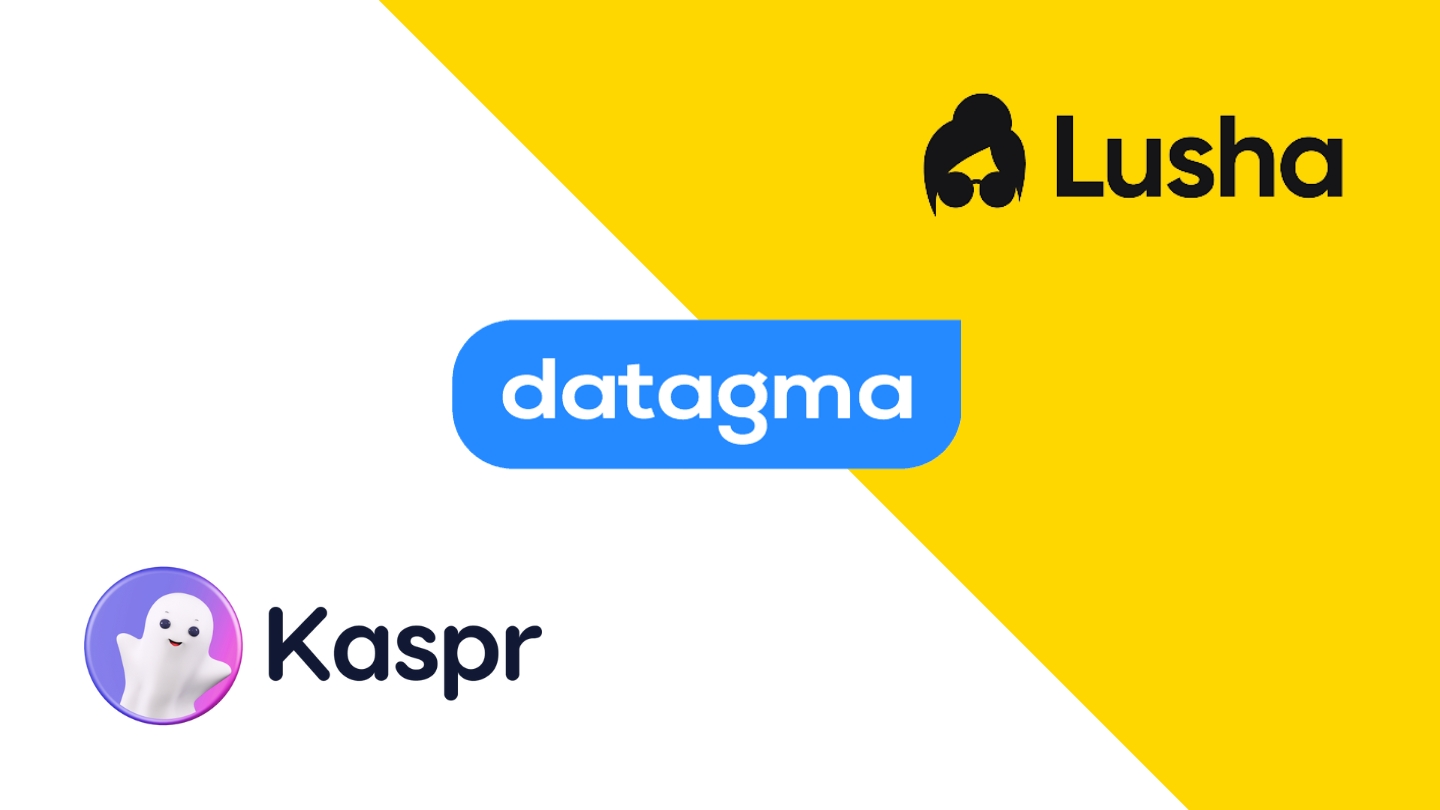The implementation of a lead (= prospect) scoring strategy has one objective: to boost sales performance. Before giving you the keys to the success of such a project, it is advisable to go back over the lead nurturing process in its entirety and to justify the interest of such a method.
Lead nurturing is usually handled by salespeople, who do most of the communication to prospects. And above all, it is the salespeople who make the most important sale. And therein lies the rub: on average, a salesperson spends only a third of their time is spent sellingand all the rest in more or less useful communications with prospects. Deploying a lead scoring system aims to improve the identification of the most interesting prospects, enabling sales teams to improve their performance by optimising their “sales time”.
To sum up, lead nurturing allows you to work on your prospects, lead scoring identifies the most interesting ones in detail, and your sales people convert them into customers.

Sommaire
Typology and structuring of prospect scoring
The central question of any lead scoring strategy is simple: which leads are most interesting for my company? Before answering this question, you need to make sure you have your company’s objective in mind. This depends to a large extent on the maturity of your company.
- A start-up company is primarily looking for a product-market fit and generally generates few leads per day. In this case, prioritisation of leads is not essential.
- In the case of a fast-growing company, lead scoring is a major issue because it ensures that the sales processes are “scaled”, optimising the available resources as much as possible.
- Finally, in the case of a mature company, the lead scoring strategy must be perfectly honed and optimised.
In general, scoring is easier at this level of development because the company has much more data and history to identify the variables to be taken into account when scoring. In other words, the company knows the typical profiles of its customers very well and will therefore be better able to identify similar profiles among prospects. Whatever your level of development, a very simple equation has been defined by Mark Roberge in “The Sales Acceleration Formula :
Score = “Compatibility” + “Pain”.
- In the case of compatibility, we try to find out whether the prospect corresponds to the type of customer targeted: does he have the necessary budget, do he have the necessary resources to use the product, is he in the desired geographical area, etc.
- For pain, the question is whether the prospect is subject to the problem solved by the company. Suitability will be assessed via socio-demographic data, pain via behavioural data. The aim of a lead scoring strategy is then to identify prospects with good fit and high pain.
Scoring lead profiles to identify a good match
First of all, you need to have socio-demographic data about your prospect. To get more information, you can increase the number of fields on your collection forms. Only if you do this, the conversion rate of your form will drop significantly.
To avoid having to face this trade-off between many prospects about whom you know little and few prospects about whom you know everything you need, you can resort to enrichment. Don’t panic, there are very simple enrichment techniques. For example, you can use Alexa Rank to get an idea of the traffic to a website, or define a list of target companies and give the prospect a “+1” if they are on it, etc.
A little advice from Salesdorado
If you want to go further, you can also use an intermediate solution such as Dataiku.
As you can see, with very little initial information, you can end up knowing much more than you need to. All you have to do is define your scoring criteria and calculate the prospect’s fit score.
Scoring the actions of its leads to identify a high level of “pain”.
There are two types of actions that speak volumes about the prospect’s pain level.
- As for the actions that reflect a high level of bread, they have in common that they are directly related to the product. For example, this could be a call for tender, a request for a quote or an add to cart. This type of behaviour reflects a real need on the part of the prospect, who will therefore be rewarded with a good bread score.
- But it does not stop there. Other less engaging actions also deserve to be taken into account in scoring, such as downloading a white paper for example. You can also go further with Dataiku, by setting up an affinity scoring based on your analytics logs.
Using lead scoring for sales and marketing actions
As we said above, lead nurturing is the continuous communication process that allows you to work on your prospects, and lead scoring is the process that allows you to prioritise them. The aim is to be able to implement relevant sales and marketing actions according to the score of your contacts.

This requires two processes.
Setting a tier score
Traditionally, lead scoring strategies aim to classify prospects into 3 or 4 groups according to their total score (“hot”, “warm”, “cold”, etc.). In reality, the aim of our strategy is only to know which prospects should be canvassed more insistently by the sales teams as a priority. So there is no need to create a multitude of groups at first, two are enough: those to be handled by your sales people on the one hand, and the others.
You therefore need to define a threshold score, beyond which the 10-15% of the hottest leads are found. The remaining 85-90% of leads will continue to receive your lead nurturing campaigns until they reach this threshold score.
Using lead scoring for sales and marketing actions
- Qualified lead (high score in fit and bread)
When the lead is qualified, your objective is to pass it on as quickly as possible to your sales staff so that they can convert it into a customer. These are the leads that interest you because you can convert them. Note that for these leads the timing is very important: it is strongly advised to interact at the most 48 hours after the prospect has passed the threshold score since their pain is still there, but it will not be there indefinitely!
- The idea being to process these leads quickly, you need to be reactive in transmitting them to your sales people. For example, you can create a list in your CRM tool that automatically captures contacts that have reached the threshold score, so that you can easily transfer them to your sales teams who will take over. Keep in mind that scoring is an iterative process and adjustments are possible.
- Leads with potential (high score in fit and low in bread, or the reverse)
You need to keep up a more or less strong marketing pressure in order to hope that you will pass the threshold score. These prospects should not be neglected because you can always turn them into customers. On the other hand, they will only have a secondary priority for you and require specific treatment.
- Email scenarios via a marketing automation solution make sense. For example, sending your newsletters, emails about product updates, or encouraging them to sign up for your trial offer. Keep in mind that at this stage, the lead is not lost, especially when they have already shown signs of interest or are in your target audience.
- Other leads (low score in fit and bread)
For these leads, which are unlikely to ever convert, you can consider applying a little marketing pressure to improve their profile knowledge, or guide them through simplified steps to prove the added value of your product.
Mistakes not to make when implementing your lead scoring strategy
Choosing the right tier score
Be careful not to define a threshold set in stone! Remember that the aim of a lead scoring strategy is to define the percentage of interesting leads for your company. It should be an iterative process, and it is up to you to define your threshold according to your past experiences.
Avoiding overly complex scoring
Keep it short and simple! You won’t be able to set up a perfect strategy the first time around. Start simple, with a small number of criteria and add new, more relevant ones as you go along. Again, it will take several iterations before you know the right metrics to consider.
Don’t let your prejudices bias you
It is not uncommon for companies to overestimate the weight of a criterion based on their intuition or past experience, to the detriment of the relevance of their scoring. It is therefore necessary to use a minimum of statistical analysis to define the right weighting for each of the selected criteria.






